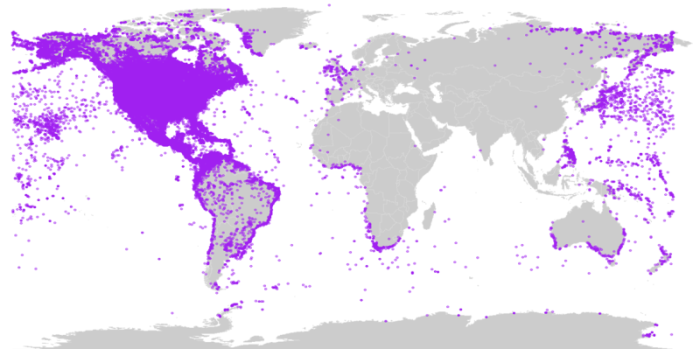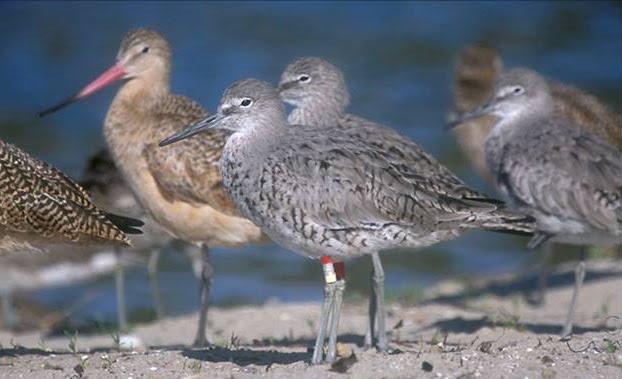HOME | satellite telemetry | acoustic telemetry | geolocators | radio telemetry | motus wildlife tracking system
individual marking | molecular markers | stable isotopes | movement models | future methods
Overview
Marking individuals is the first step in understanding migratory connectivity throughout the full life cycle. Despite advancements in technology, the capture and marking of an animal will always be the foundation of all migratory connectivity research.
International, Federal, and State permits are required prior to touching wild animals. Provincial and local regulations must be explored as well. A thorough review of methods for individual marking, including ethics and other considerations, can be found in Silvy et al. 2012.
Bird Banding
Bird banding is one of the oldest methods of marking individuals for scientific studies. The process involves placing an aluminum band with a unique identification number issued by the federal government on the bird’s leg. Some studies also use colored plastic bands to help identify individuals without the need to recapture and read the unique number printed on the band. Bird banding is used to answer questions about movement, survival, behavior, life history, and more (Cleminson and Nebel 2012).
The first systematic use of bird banding in America began by Smithsonian scientist Dr. Paul Bartsch in 1902. He initiated a study of Black-crowned Night-Herons at the National Zoo in Washington, DC. This small study later expanded into the Bird Banding Laboratory in 1920 after the 1916 Migratory Birds Convention (Tautin 2005). With over 5 million bird banding encounters dating back to 1914, banding records form the basis of the Atlas of Migratory Connectivity.

Locations of all bird band re-encounter records from the Bird Banding Laboratory. Map by Amy Scarpignato.
Banding Schemes
All bird banding activities in the United States and Canada are regulated by the U.S. Geological Survey (USGS) Bird Banding Laboratory (BBL). The BBL issues permits and bands and manages all bird banding and recovery data.
Bird banding (also known as ringing) in Europe is coordinated by the European Union for Bird Ringing (Euring). European countries have their own National Ringing Schemes within Euring.
Other countries outside of Europe, the United States, and Canada have their own ringing schemes which can be found here.
Individual Marking by Taxa
While most of this page highlights individual marking methods for birds, there are unique methods used for other taxa. The choice of marking method should depend on the species and researchers should take into consideration the effects of the technique on the individual animal.
In some cases, it is possible to distinguish individuals based on natural markings, such as unique coat patterns, fin patterns, or bill patterns (Silvy et al 2012). When this is not possible, marking techniques are needed to allow the researcher to identify individuals. A number of reviews have addressed the potential effects of marking on vertebrates (Murray and Fuller 2000) and on specific taxa, such as marine mammals (Walker et al. 2012).
Birds
- Bands and collars
- Claw, feather clipping
Terrestrial Mammals
- Metal or plastic tags (neck collars or ear tags)
- PIT tags
- Toe clipping, branding, tattooing, fur clipping
Marine Mammals
- Dorsal fin, flipper tags
Fish
- Plastic or metal tags
- PIT tags
- Fin clipping
- Pigment
Reptiles and Amphibians
- Branding
- Pigments, dyes, other substances
- PIT tags
- Plastic or metal tags
- Toe clipping
Invertebrates
- Pigment


References
- Chapman, J.W., V.A. Drake, and D.R. Reynolds. 2011. Recent insights from radar studies of insect flight. Annual Reviews of Entomology 56:337-356.
- Cleminson, A. and S. Nebel. 2012. Bird Banding. Nature Education Knowledge 3(8):1.
- Galdino, C.A.B, G. Horta, and R.J. Young. 2014. An update to a bead-tagging method for marking lizards. Herpetological Review 45(4):587-589.
- Hupman, K., K.A. Stockin, K. Pollock, M.D.M. Pawley, S.L. Dwyer, C. Lea, and G. Tezanos-Pinto. 2018. Challenges of implementing Mark-recapture studies on poorly marked gregarious delphinids. PLoS ONE 13(7):e0198167.
- Jungwirth, A., V. Balzarini, M. Zöttl, A. Salzmann, M. Taborsky, and J.G. Frommen. 2019. Long-term individual marking of small freshwater fish: the utility of Visual Implant Elastomer tags. Behavioral Ecology and Sociobiology 73(49).
- Murray, D. L., and M. R. Fuller. 2000. A critical review of the effects of marking on the biology of vertebrates. Pages 15–39 in Boitani and T. K. Fuller, editors. Animal Home Ranges and Territories and Home Range Estimators. Columbia University Press, New York.
- Silvy, N. J., R. R. Lopez, and M. J. Peterson. 2012. Research: Techniques for Marking Wildlife. Pages 230–257 in J. Silvy, editor. The Wildlife Techniques Manual. Seventh edition. Johns Hopkins University Press, Baltimore, Maryland.
- Tautin, J. 2005. One hundred years of bird banding in North America. USDA Forest Service Gen. Tech. Rep. PSW-GTR-191.
- Walker, K.A., A.W. Trites, M. Haulena, and D.M. Weary. 2012. A review of the effects of different marking and tagging techniques on marine mammals. Wildlife Research 39(1):15-30.
HOME | satellite telemetry | acoustic telemetry | geolocators | radio telemetry | motus wildlife tracking system
individual marking | molecular markers | stable isotopes | movement models | future methods






